Deceptionists at War
Martial magic
Jonathan Allen
Great liars are also great magicians.
—Adolf Hitler
On January 1st, 1945, a chicken named Elmer Gwynne was appointed as a sergeant in the United States Army (#A C311). The bird featured in the act of magician Jack Gwynne who, together with his wife and stage assistant Anne, was a member of the United Services Organization performing to battle-weary troops in Calcutta. Elmer’s appointment had come about after concerns were voiced over soldiers’ keeping potentially rabid squirrel monkeys as pets. To circumvent the subsequent ban on all animals within army ranks, Gwynne’s avian stage property was bureaucratically anthropomorphized “in appreciation” of its “successful mission in entertaining the Troops of our Armies.”[1] Elmer provided the intended morale boost to the theater troupe, despite later requiring protection when Jack Gwynne noticed poorly nourished soldiers in the remotest part of India and Burma gazing longingly at the bird, leading him to appoint a dedicated bearer and guard.[2]
This story of magic’s presence within the theater of war emerges during a period of relative optimism for the Allies during the closing months of World War II. However, the anticipation of hostilities and the entrenched business of war produce another account of battlefield magic, one in which encounters between individual magicians and governments reveal much, as the latter co-opt the expertise of professional deceivers at a time of crisis and the former respond to power’s solicitations for their own material and ideological ends. As politically acceptable levels of cunning and conning shift in anticipation of and during conflict, professional cheaters of perception therefore often enter—or perhaps re-enter—the military academy.
The methodology (and lexicons) of the battlefield tactician and that of the magician find much common ground. As a highly skilled misdirector within visual and verbal fields, a magician’s role is to propose one account of reality while another takes quite a different and effective course. Continually decoying, feinting, rusing, and dazzling, magicians are daring choreographers of phantom spaces and gestures, willful and motivated illusion designers—in short exceptionally proficient and opportunistic liars. A theorist who has analyzed this relationship is Barton Stewart Whaley, whose recent publication Detecting Deception: A Bibliography of Counterdeception Across Time, Cultures, and Discipline (2006) is now considered one of the gateway documents for any serious researcher of the history of deception not just in warfare but in a wider cultural context. For Whaley, deception is the intentional distortion of another’s perceived reality and can be divided into two clear categories: dissimulation (hiding the real), and simulation (showing the false). Within dissimulation, he identifies three modes: masking (hiding the real by making it invisible), repackaging (hiding the real by disguising), and dazzling (hiding the real by confusion). Under simulation, he describes mimicking (showing the false through imitation), inventing (showing the false by displaying a different reality), and decoying (showing the false by diverting attention). Elsewhere, Whaley compared this taxonomy of deception with the strategies used by professional magicians and discovered a distinct correspondence in the order of decreasing effectiveness within both fields. He further noted that both military tacticians and magicians frequently combined strategies from each category in highly inventive and targeted ways.
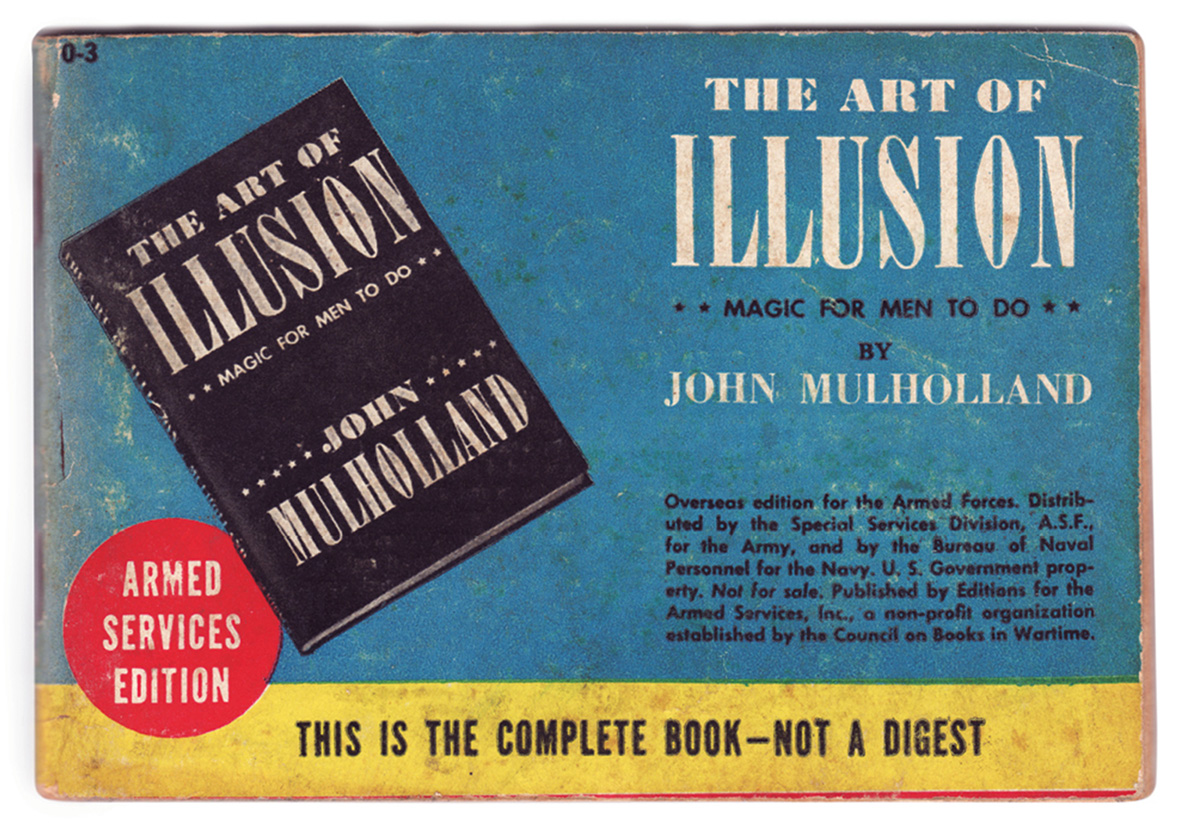
Simulation and dissimulation feature within, but also distort, the story of modern European history’s best-known combat magician, Jasper Maskelyne (1902–1973), whose bravura experiences as a magician-camoufleur in North Africa during World War II were popularized by writer David Fisher in The War Magician (1983). The grandson of an established and respected theatrical magic dynasty, Maskelyne was, Fisher writes, the moving spirit behind a collective of theater professionals, artists, and fabricators gathered by the British Army in 1941 to implement its tactical deception strategy during the North African Allied campaign. Under Maskelyne’s leadership, the “magic gang,” as this motley crew was known, evolved crucial tactical diversions, including the successful camouflaging of the city of Alexandria from aerial bombardment, the mobilization of phantom tank battalions using the “sunshield” vehicle decoy system, and the implementation of a unique configuration of large-scale rotating dazzling-mirrors used to confuse German pilots approaching the vulnerable Suez Canal. The War Magician was the basis for two recent television documentaries that faithfully presented this legacy. Rumors of a Hollywood vehicle have circulated since 2001, with Tom Cruise cited as the probable lead.
Given the centrality and tenacity of this story in the public, and increasingly professional media imagination, it is important to clarify the detail of Maskelyne’s contribution. Although Maskelyne did play an active role during the relevant conflicts, David Fisher’s book, the basis of the largely unchallenged progression described above, is apocryphal, drawing the majority of its material from Maskelyne’s own memoir Magic–Top Secret (ghost-written by Frank S. Stuart in 1949), a volume that military historian and magician Richard Stokes has shown recently to be historically precarious.[3] Maskelyne’s actual contribution within the theater of operations was of substance but limited mainly to the adaptation and deployment of existing camouflage and decoy technologies, rather than the exaggerated, seemingly magic-inspired innovations that Fisher recounts. The development of a miniature compass disguised as a jacket button can almost certainly be traced to Maskelyne’s originating expertise, as can the production of particularly high-quality printed silk maps. Trompe l’oeil conceits including exploding coal and booby-trapped animal-dung (to tempt the bored drivers of German troop vehicles) also seem to have fallen within his creative remit. At these exacting and smaller-scale challenges he excelled, as one might expect from a man who had grown up in the theater wings and magic workshops of the internationally renowned St. George’s Hall in London. Most of the larger scale projects, however, were undertaken, with limited input from Maskelyne, by the British Royal Engineers, for whom the deployment of deception strategies was standard operational practice. Stokes even suggests, but does not pursue, the seductive notion that Jasper Maskelyne’s presence may have been deliberately exaggerated from within the military establishment itself, his family’s magic brand being used as a tool of propaganda. With a “Maskelyne” in charge of deception operations, what ever could the German High Command expect next? The magician himself, in other words, may have been used unwittingly as an illusionary force.
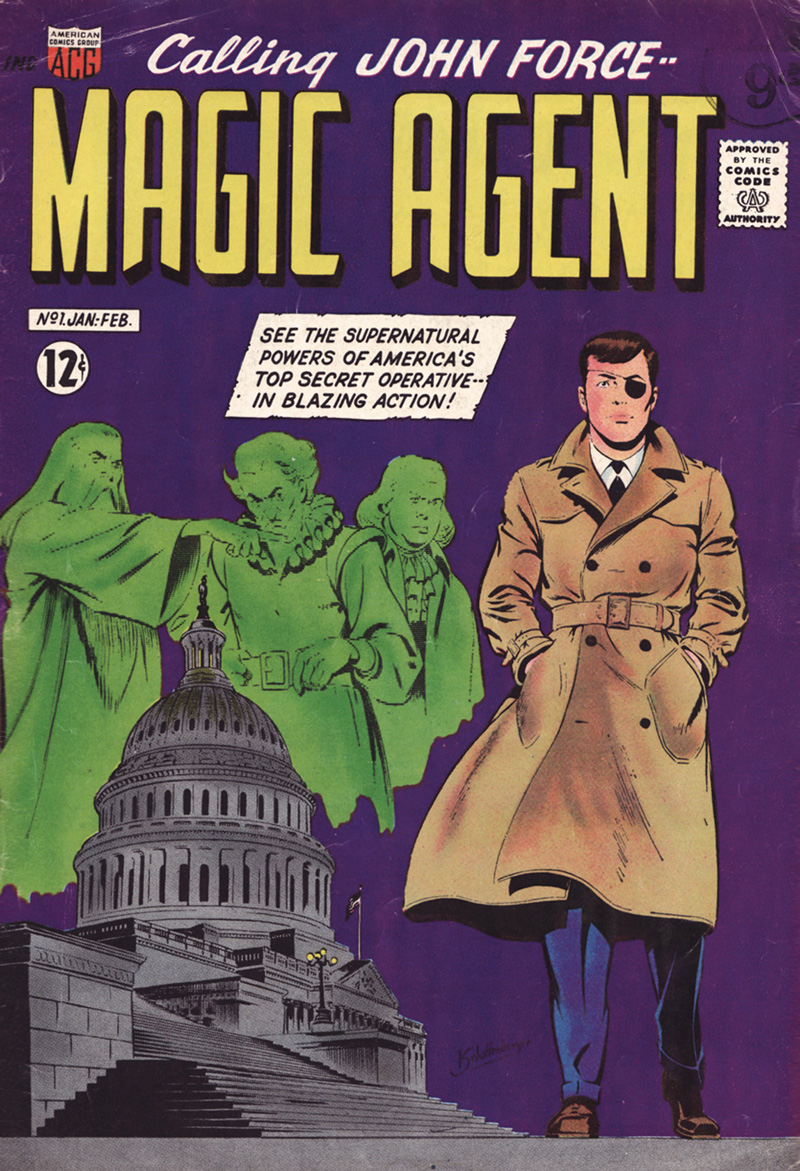
For many magicians, however, the narrative detail of The War Magician is more problematic because it points so clearly to the seminal but romanticized exploits of French illusionist Jean-Eugène Robert-Houdin who describes in Confidences d’un Prestidigitateur (1858) the quelling of a colonial uprising in North Africa using magic tricks alone. Robert-Houdin’s well-deserved retirement after a lifetime serving the art of magic was interrupted, he writes, by a letter from Colonel de Neveu, head of the French political office in Algiers. French control within the region was under threat as the result of Marabout sorcerers who were stirring “the fanaticism of their [Arab] co-religionists” using beguiling displays of magic. Neveu now sought Robert-Houdin’s expertise in their suppression. With the assistance of an onstage simultaneous translator, Robert-Houdin played the part of a French miracle-worker, producing cannon balls from a top hat and performing the famous Bullet Catch routine, the Heavy-and-Light Case, and a version of the Inexhaustible Bottle, coups de théâtre politiques that so alarmed his Algerian audience that some fled from the theater itself.
Although now a valuable guide for the contemporary reader to the landscape of magic’s early Golden Era, Confidences d’un Prestidigitateur also played an important mythologizing role for Robert-Houdin as a performer. Masquerading as a respectable confessional autobiography, the book could be seen as an early example of a magic subgenre that would later evolve into what is now tolerated affectionately within magic circles as a “bullshit biography.” As almost offstage props in themselves, these often highly colored semi-fictions distributed within the public domain contribute to the maintenance of a functional aura of mystery around the persona of the performer and form a crucial part of the concatenation of aesthetic, psychological, and economic incentives that lead audiences to yield to the existentially ludicrous proposition of a man or woman standing on a stage pretending to perform miracles. Given that Jasper Maskelyne was still performing when he published his memoir, by all accounts in full military regalia despite the cessation of hostilities, Magic–Top Secret operates, I suggest, within this sphere. David Fisher’s book The War Magician, in contrast, belongs to the world of television and film options.[4] Maskelyne, who had never been a passionate inheritor of his family legacy, died an embittered driving instructor in South Africa in 1973, disappointed nevertheless that he had not received the recognition he felt he deserved, a victim in other words, of his own self-mythologizing.
In Great Britain, another source of magic fictionality during World War II was the Demon Telegraph, an underground trade magazine published intermittently by the Davenport Magic Company from their London premises and which, despite acute paper shortages, continued to supply magicians with props and routines, often with explicitly combat-related themes. The British wartime prime minister Winston Churchill appears often within its pages, in one case in the form of a detailed engraving subtitled “The Great Magician.” In another, the “British Bulldog,” as Churchill was known, has undergone a metaphorical species change and is seen within an illustration by Laurie as a tail-coated white rabbit displaying Churchill’s famous victory sign next to a top hat issuing the flags of the victorious Allied nations. This vexillological fountain of patriotism has identifiable roots in magic’s iconographical history, “flag sprays” being the functional props in a production illusion originated by Carl Hermann (1816–1887) and known variously as Emblems of All Nations, Congress of Flags, and Greetings of the Nations. Here, an empty-handed magician appears on stage and within moments is surrounded by numerous billowing silk flags, his body the center for the spontaneous production and choreography of diversified nationhood, all accompanied from the orchestra pit with appropriate patriotic anthems.
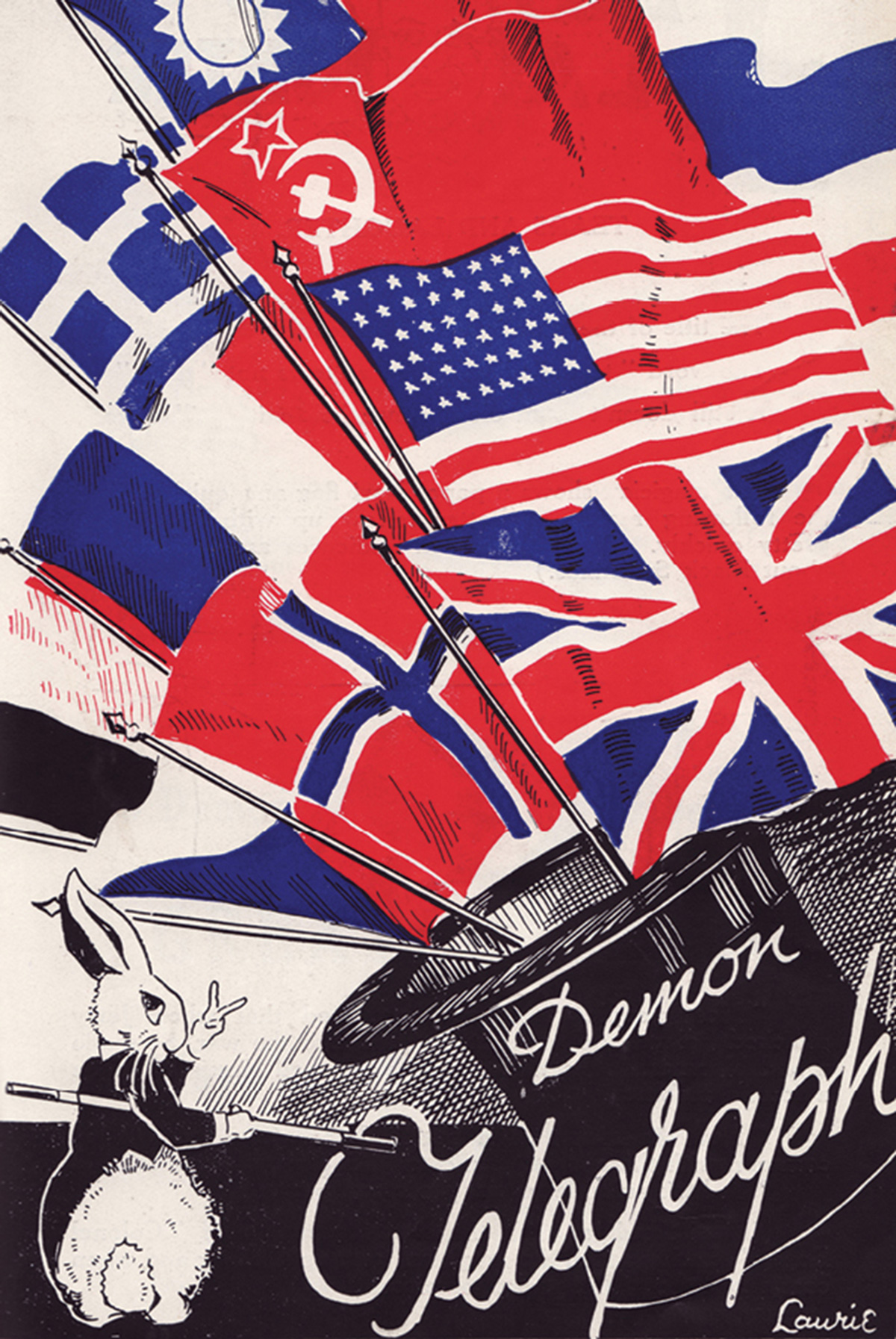
The German magician who has most attracted the attention of commentators due to his rumored association with the emerging Third Reich is Erik Jan Hanussen (né Hermann Steinschneider, 1888–1933), the subject of a comprehensive book by historian Mel Gordon, and three films (Hanussen, Fischer and Marischka, 1955; Hanussen, István Szabó, 1988; Invincible, Werner Herzog, 2001). There is another, lesser-known magician however, whose confirmed proximity to Nazi power in the years before, during, and after World War II, makes him perhaps one of the most important, and without doubt the most problematized, war magicians of the twentieth century.
The story of Kalanag (stage name of Helmut Schreiber, 1903–1963) is complex. His reputation (and props) currently lie in tatters among the majority of the magic community, as a result of the confirmation late in his career and since of his sympathetic interaction with high-ranking members of the Nazi party, including, among others, Hermann Göring, Joseph Goebbels, and the Führer himself. It does seem, however, that Schreiber’s passion for magic was the one unbroken thread throughout an opportunistic life. He was installed as the president of the German Magic Circle in 1936 (presiding over its anti-Semitization during the following years) and was editor of the German magazine Magie between 1927 and 1945. After the war, he emerged to develop one of the most lavish, and indeed last, illusion spectaculars of its kind in the twentieth century, The Kalanag Magical Musical Revue (sometimes referred to as Sim Sala Bim), that carried Schreiber and his wife Gloria De Vos worldwide from the late 1940s until the magician’s death in 1963.
Another important focus of Schreiber’s professional life was his close involvement with German film production. Before the outbreak of war, he had held a position at Tobis Film Company and in 1942, within the newly nationalized German film industry, was promoted personally by Reichminister Goebbels to production chief of Bavaria Filmkunst in Munich, and simultaneously appointed to the advisory board of the Reich’s Film Academy.[5] This places Schreiber, “the virtual czar of conjuring”[6] in Germany during the period, at the very center of Nazi film production in the build-up to and throughout World War II. Whether or not magic’s capacity for persuasive illusioneering shaped in any way the one hundred and fifty or so films he produced during this time is a compelling question, with less clear answers.
Photography did, however, prove significant for Schreiber in another way, for it confirms his presence as a magician before Adolf Hitler in person. In an extraordinarily candid image, a gathered audience draws near as Schreiber performs to a seated and relaxed Führer. A trick is underway, and the moment caught by the photographer is the anticipation in advance of effect, one that remains forever deferred. The sight lines within the assembled group are of interest, for in contrast to the fetishizing gazes that are normally seen to fix upon and transform the Führer’s totemic body, it is clear that some of the audience have positioned themselves in order to see past him. Here at least, the operative magic rests in Schreiber’s hands and in whatever transformative power they might release. One detail breaks this closed world. An unidentified man in the top left corner stares directly into the camera lens and, with a faint smile breaking across his lips, witnesses our gaze, implicating us within the narrative logic of the image rather than safely upon its surface.
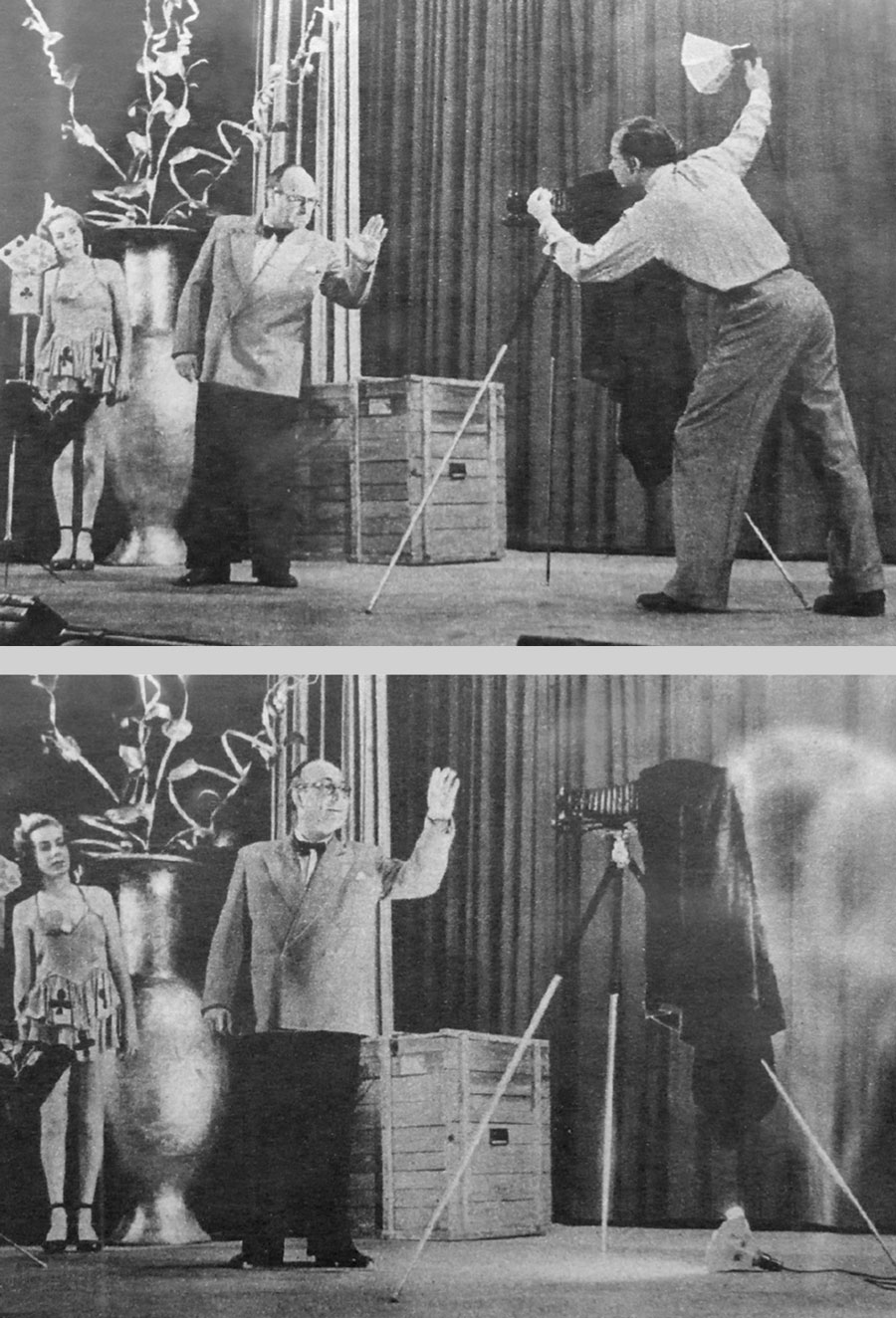
As Schreiber’s largely unacknowledged past began to emerge more publicly near the end of his career, he might well have yearned to possess the powers which he seemed to wield in a photographic diptych published in Badische Illustrierte in 1949, during the early years of his post-war success. In a tableau clearly staged for the purposes of the magazine story, the magician is seen to “vanish” an intrusive photographer who tries to capture his stage secrets on film. In retrospect, however, the diptych becomes a photographic augur, since Schreiber’s inability to control the photographic records of his association with the Third Reich proved fatal to his reputation.
During a personal visit to Hitler’s “Berghof” retreat in the Bavarian Alps, Schreiber is said to have “putpocketed” the Führer by placing 150 Deutschemarks on his person during a show, much to his great surprise. Putpockets feature again in an example of covert propaganda developed within the Political Warfare Executive in 1943 under the leadership of Sefton Delmer and executed by forger Ellic Howe from offices at the BBC’s Bush House in London.[7] Howe oversaw the production of over five thousand Efka cigarette paper packets containing ten tightly folded sheets of bible paper, each printed with a text explaining how to fake a variety of illnesses. Covert agents working behind enemy lines then placed the packets secretly into the pockets of soldiers and civilians, with the longer-term aim of depleting German forces from within. By discretely arming individuals with scripts for malingering, the pocket offensive turned many into hypochondriacal actors who delivered to their superiors coughing and aching performances that may have saved their lives.
In 1944, American magician John Mulholland’s popular how-to-do-magic book The Art of Illusion was republished in miniature by the Armed Service Editions so that it could be carried in the shirt pockets of US soldiers for their entertainment and diversion. The ludic versatility of playing cards had long been understood as a tool of morale for soldiers, and now Mulholland’s book, in amongst other tricks, multiplied the deck’s possibilities. During the Cold War, however, Mulholland’s patriotism became more complex. His second written contribution to a warring United States government was an unsigned internal document for the CIA entitled Some Operational Uses for the Art of Deception, as part of MKULTRA, the notorious program established in the 1950s to explore the tactical use of hallucinogens in an attempt to narrow the perceived “mind control gap” that was developing between the US and its Cold War adversaries.
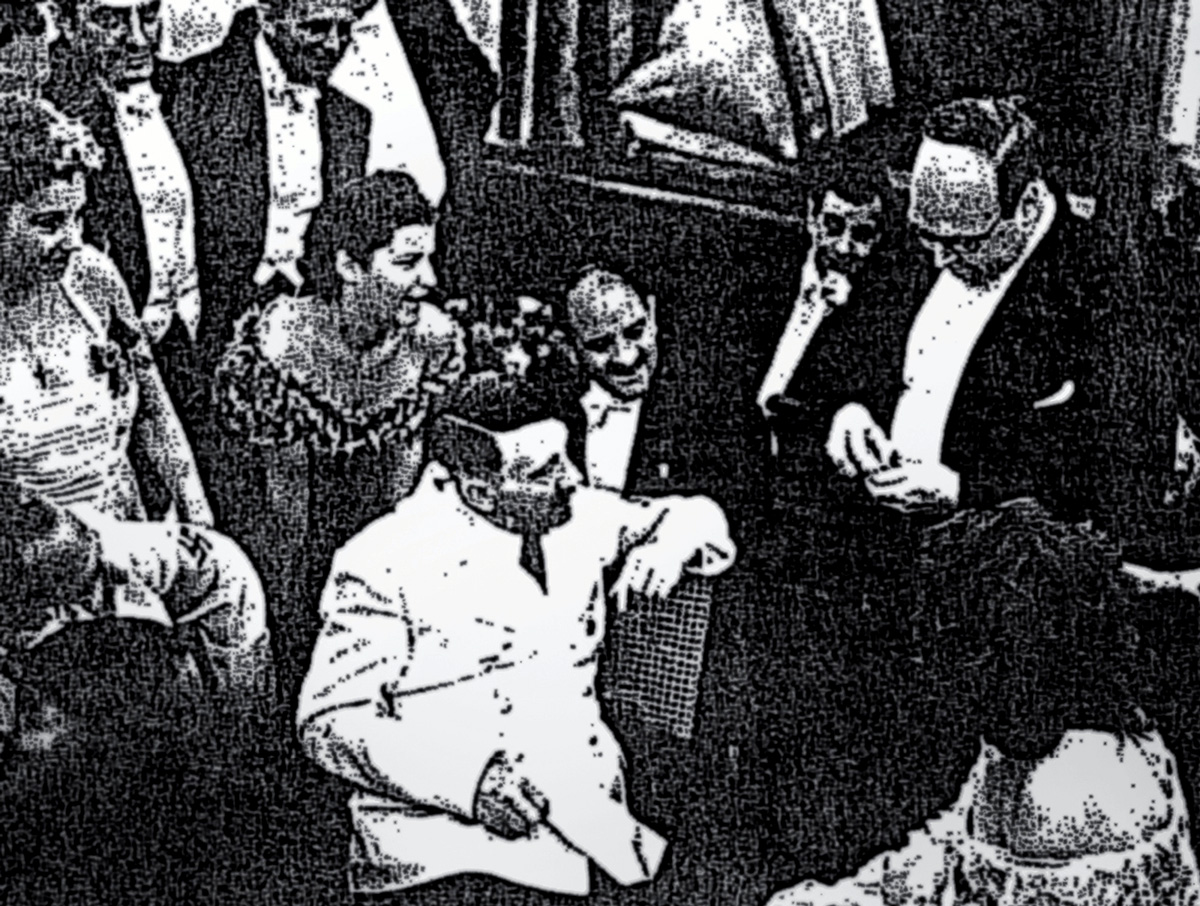
“The purpose of this paper,” Mulholland wrote in his 1954 document, “is to instruct the reader so he may learn to perform a variety of acts secretly and undetectably. In short, here are instructions for deception.” To assist agents in the covert administering of toxins, the document describes tricks with pills, tricks with loose solids, tricks with liquids, and “tricks by which small objects may be obtained secretly.” Another section described modified or different techniques for use specifically by female agents. This was a document, in other words, that outlined methods for using magic to kill.[8] The circumstances of the death of Alexander Litvinenko in November 2006 following polonium poisoning in a London health-food restaurant suggests that some of these techniques may not have lost their efficacy.
Within a section titled “Handling of Tablets,” two Mephistophelean self-portraits confirm Mulholland as the author of the document. According to historian Michael Edwards, the drawings illustrate a section in which the magician warns the would-be performer to guard against accidental facial tells. “A psychological-physical fact,” Mulholland writes, “which applies to the performance of the above trick in all its variations, as well as in the performance of all other tricks, must be noted because of its great importance. The fact is that physically, at the moment of doing any action requiring concentrated thought, there is an alertness of appearance which is very noticeable. A sudden alertness on the part of the performer causes wariness on the part of the spectator.” Mulholland recommends adopting a “mildly stupid appearance,” to relax one’s facial muscles, and throwing one’s eyes out of focus in order to feign disinterest.
Although merely illustrating a performance technicality, these inadvertent self-portraits could also be read in the context of the long history of images in which artists scrutinize their own features for signs of physical or moral turpitude. Mulholland’s ambivalence about his involvement with the CIA is evidenced more overtly, however, in the distinction he makes with the titles of his two combat-magic publications, between the art of illusion, and the art of deception. Illusion, with its Latin roots in ludere, to play, suggests cooperation within the ethics of the encounter between audience and magician, a “willful play of confidences between viewer and spectacle.”[9] Deception however, drawn from decipere, to ensnare or cheat, suggests a will to prevail, a more divisive exchange, and one with potentially lethal stakes.
Magic iconography and Cold War paranoia blur within popular culture during the same period in the figure of John Force, or Magic Agent, a short-lived American Comics Group character created in 1961 by Richard E. Hughes.[10] Government agent John Force possessed no extraordinary skill until the ghosts of Nostradamus, Merlin, Cagliostro, and Houdini appear before him during his imprisonment in occupied France during World War II. The spectral quartet gives him a crypto-scientific device that allows him to summon powers of extra-sensory perception, telepathy, hypnosis, and illusions. Now working for the nebulous “American Security Group,” John Force triumphs over successive foes of the United States, including Major Immelman of Nazi Intelligence, Dr. Petrov of the Slovenian Secret Police, and Hindu insurgent Mahatma Regor Varnath.
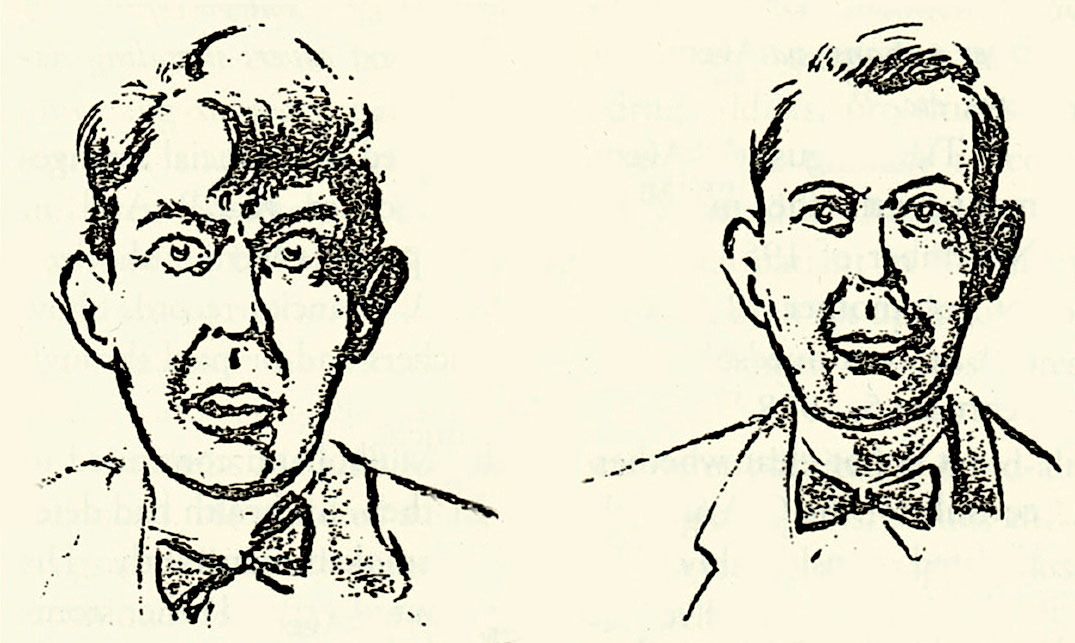
Conspiracy theorists have long invested the iconography of the current US dollar bill with quasi-magical significance, seeing within its complex illustrations evidence of United States involvement with everything from Masonic-Rosicrucian-Illuminati elites to extraterrestrials, and even owl cults. Resembling a large coin-like medallion, John Force’s device suggests a clearer link between state power, economic capital, and magic’s directed application. Its face shows a bas-relief four-columned classical façade derived from the US Capitol building in Washington, DC, above which Magic Agent’s ghostly attendants are seen to hover on the comic’s first-issue cover. When individually pressed, the columns grant John Force his powers. Capital thus fuses with Capitol to generate operative magic in the service of American political idealism and territorial ambition. When deprived of this device, John Force is rendered powerless, becoming lethargic and susceptible to manipulation.
The ghosts hovering throughout the pages of Magic Agent point to a continuum of cunning that reaches back to Sun Tzu’s fourth-century BCE meditation on battlefield strategy in The Art of War, through to Niccolo Machiavelli’s (1469–1527) reflections on guile and political power in Renaissance Italy in Il Principe, and up to Barton Whaley’s contemporary taxonomies of deception. John Force’s creator Robert Hughes also inadvertently tracks his character’s technological predecessors and future embodiments. In a story that evokes Jasper Maskelyne’s makeshift dummy-tank campaign in North Africa, the eye-patched and forever rain-coated agent presses “the pillar of illusion” to conjure a phantom armed battalion which materializes and dematerializes during a desert battle to the dismay of generic rebel forces. Elsewhere, “the pillar of extra-sensory perception” lets him see through solid surfaces—the stuff of children’s fantasies in 1962, but now a commonplace on the modern battlefield in the form of thermal-detector-equipped vehicles such as the appropriately named Magic Warrior / Nightstalker Humvee.
Machiavelli’s advice that a leader should never attempt to win by force that which he might “win by fraud” was played out to great effect by Fidel Castro, who countered the cunning of US propaganda through the simple use of trained java doves during his first televised speech to the Cuban nation in January 1959. The doves that landed and remained upon Castro’s body throughout his oration found a symbolic resting place in the simultaneous codifications of Catholicism (the Holy Spirit) and Santeria (Obatalá—a creator divinity), triggering immediate and awed responses in the assembled crowd.[11] This apparent divine confirmation of the legitimacy of Castro’s ascendancy would have required several weeks of careful avian training using a uniformed and bearded stand-in for the leader himself. Another act of politicized counter-magic, and one that despite its apparent failure had huge mobilizing power, was stage-managed by Abbie Hoffman, activist and co-founder of the Youth International Party, who in October 1967 gathered some 35,000 anti-war demonstrators in Washington, D.C., in an attempt to levitate the Pentagon by psychic power alone and, once aloft, wobble the building to exorcise its war-mongering evil spirits.
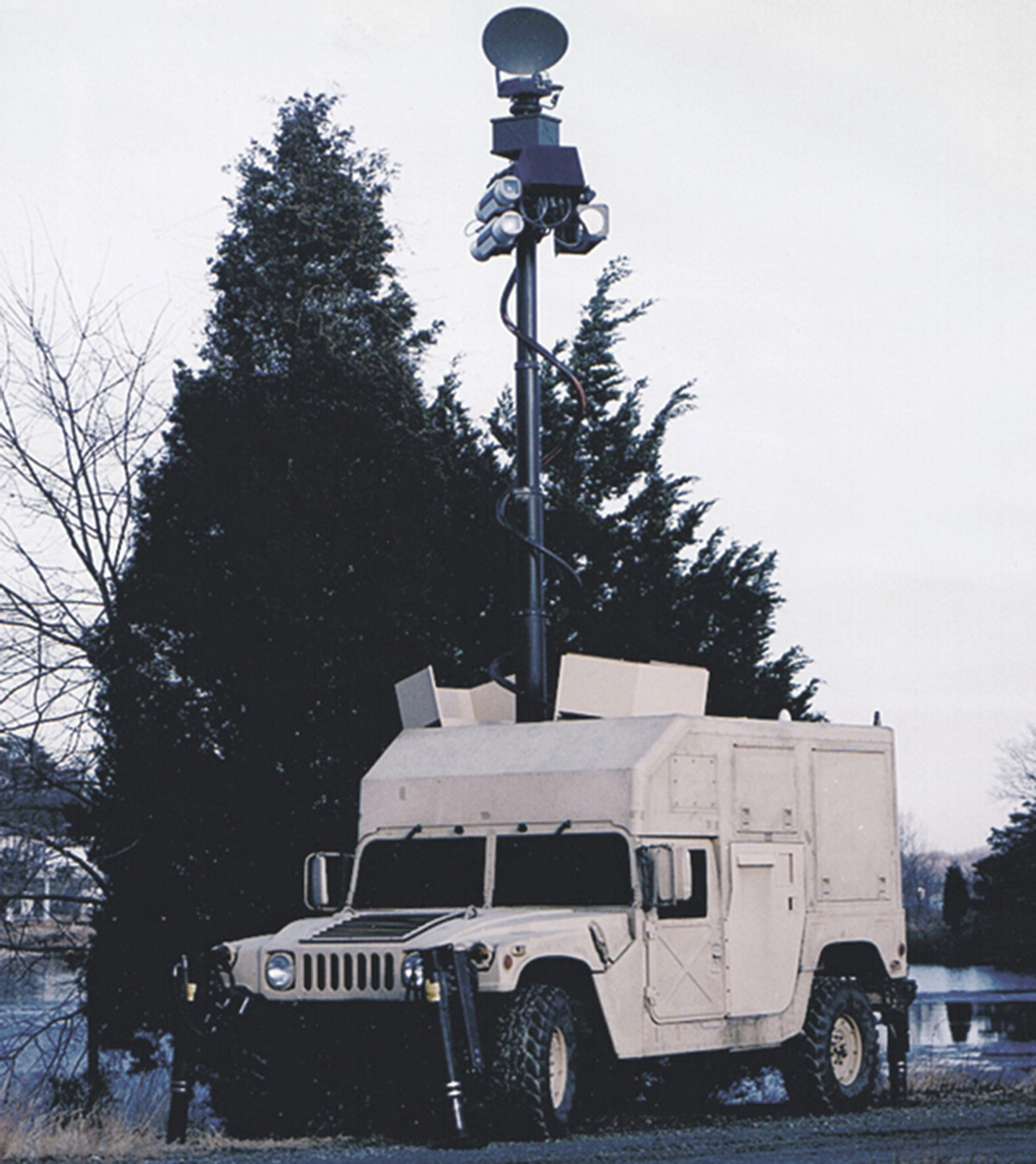
Just three years later, a young Republican, Karl Rove, tested techniques that would later gain him a reputation as “the Magician” within the G. W. Bush White House. Using a falsified ID, Rove stole a thousand sheets of stationery from the campaign office of Democrat Alan J. Dixon that he later used to create a flyer that read: “Free beer, free food, girls and a good time for nothing.” These he distributed at rock concerts and homeless shelters in an ultimately unsuccessful attempt to disrupt Dixon’s election. Rove dismissed his conduct in 1999 as a “youthful prank,” yet in this act of simulation-invention, and later within his trivialization of the event (dissimulation- repackaging), one can distinguish a distinctly Whaleysian style of governance that, on many occasions since, has targeted and mobilized the fantasies of its electorate through techniques that Steven Duncombe has defined recently as opaque or “delusional” spectacle.[12]
If Karl Rove has opportunistically misdirected the perceptions of a post-Baudrillardian, media-sated, and reality-disoriented electorate, then in so doing he has become a war magician for an era of permanent war, a John Force-like deceptionist with the full resources of American economic and military transformative power waiting in the wings. And if a covert war magician weren’t sufficient to promote Neoconservative idealism, then G. W. Bush himself became its visible embodiment, when, in New York in 2004, he took to the stage at his party’s convention with Vegas-inspired élan. As two huge video-screens-on-wheels bearing rippling American flags crossed each other on stage, a smiling and spotlit President suddenly materialized. It was as if Carl Hermann’s flag illusion, Emblems of All Nations, had come of age, although not as a celebration of diverse interdependent nationhood, but rather as self-congratulatory, recalcitrant Unilateralism.
- Captain P. D. Whitefield, Letter A.P.O. 722, China Burma India Theater Command, Jan 1945. Reproduced in David Charvet, Jack Gwynne: The Man, His Mind, and His “Royal Family of Magic” (Washington, DC: Charvet Studios, 1986).
- In southwest Thailand during the same period, Fergus Anckorn [1918–], a British prisoner of war, performed intermittently, and alone, to the magic-enthusiast commandant of Chungkai detainment camp. Anckorn’s repertoire was limited to one-handed tricks following a crippling shrapnel injury, whilst its iconography was almost exclusively food-related—variations on egg tricks, a banana that appeared to slice itself from within, and a coin trick with a tin of fish. Anckorn had quickly established that the Japanese commandant would discreetly leave aside any foodstuff touched by the magician during his act. This unspoken gift economy established through a hybrid of theatrical and contagion magic undoubtedly saved Anckorn’s life, for, despite reaching a weight of less than thirty-two kilos during his imprisonment, he returned to England in December 1945 and eventually resumed his pre-war performing career after repeated surgery to restore the prestidigitationary prowess of his shattered hand.
- In a series of twenty-one articles published between November 1997 and October 2005 in the Australian magazine Geniis Magic Journal, military historian and magician Richard Stokes dismantles The War Magician, contextualizing David Fisher’s account within contemporary literary and military sources, and with close reference to the recollections of Jasper Maskelyne’s surviving son, Alistair Maskelyne.
- British performance artist Marisa Carnesky (in association with military historian writer Robert Greene) foments the ambiguity of these semi-fictional accounts in Magic War (2006). Using live magic and spoken word, Carnesky played a wayward Athena/Orlanda-like figure moving across centuries, inspiring the cunning of warrior-magicians including Odysseus at Troy, Robert-Houdin in Algeria, and Jasper Maskelyne in Egypt.
- Richard Hatch, “Kalanag and the Vanishing Banknotes,” Magic Magazine, July 1998, pp. 48–53.
- Milbourne Christopher, The Illustrated History of Magic (New York: Thomas Y. Cromwell Company, 1973), pp. 401–404.
- Illness Saves by Dr. Do Good: The British Black Propaganda Malingering Campaign, with a foreword by Lee Richards (Peacehaven, UK: Psywar.org, 2006.)
- Michael Edwards, “The Sphinx and the Spy: The Clandestine World of John Mulholland,” Genii Magazine, vol. 64, no. 4 (April 2001), pp. 22–39.
- “Con Art” was an international group exhibition which explored art and conjuring’s shared principles of “cunning and conning” through a gallery exhibition, symposium, and live performance events. Initiated and curated by Helen & P. G. Varola, Carol Maund, and myself at Site Gallery, Sheffield, UK, in 2002.
- Magic Agent, American Comics Group, vols. 1–3, January–June 1961.
- Ivor L. Miller, “Religious Symbolism in Cuban Political Performance,” The Drama Review, vol. 44, no. 2 (Summer 2000), pp. 30–55.
- Steven Duncombe, Dream: Re-imagining Progressive Politics in an Age of Fantasy (New York: The New Press, 2007).
Jonathan Allen is a London-based visual artist, writer, and sometimes stage magician. His performance alter ego Tommy Angel has performed recently at Tate Britain, the De La Warr Pavilion, and the first Singapore Biennale. Recently awarded the Helen Chadwick Fellowship at the British School in Rome, Allen will present his current project Kalanag at David Risely Gallery, London, in early 2008. For more information, visit www.jonathanallen.info.